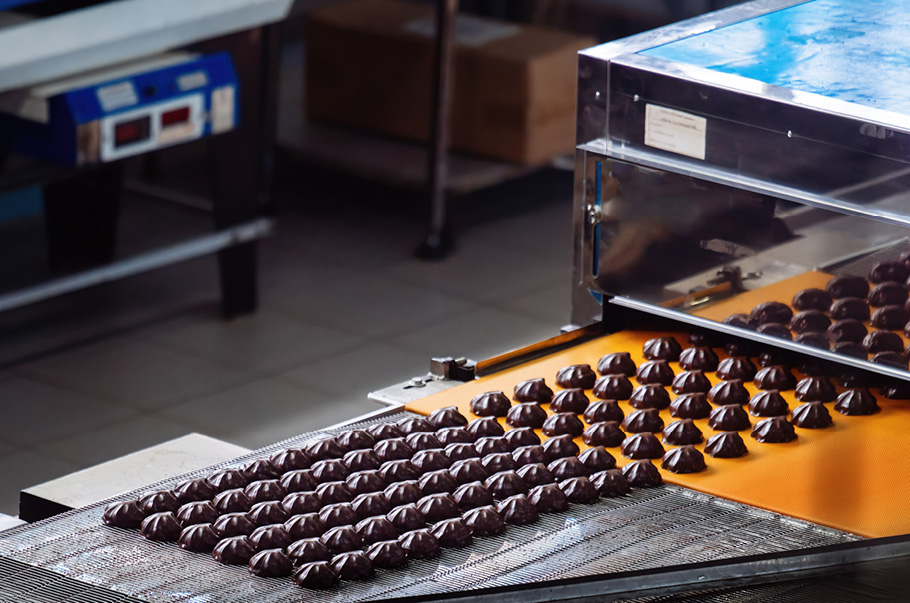Facing many challenges
In the year 2023, despite the more stable situation of the Polish economy, the confectionery industry required a flexible approach and quick responses to changing operating conditions related to, for example, raw material prices or rising costs. The decline in consumer purchasing power was expected to translate into lower demand for products that are not essential to the daily diet, including confectionery. In contrast, the short-term challenges have not affected the health of the industry, which is forecasting continued value growth in the overall market.
Consumption
Sweets accompany Poles both on a daily basis and on special occasions. This brings the total consumption of chocolate by the average Pole to almost 6 kg per year. According to Euromonitor International’s forecasts for the coming years - chocolate confectionery consumption in Poland is set to rise. In 2028, it is expected to reach 6.4 kg per capita per year.
However, we are far behind Germany in terms of consumption, with its citizens eating an average of 8.4 kg of chocolate sweets per year. Equally high are the inhabitants of Ireland, who consume about 7.7 kg per year, the inhabitants of Sweden 7.4 kg, Great Britain 7.2 kg and Bulgaria 6.6 kg. In contrast, residents of the Netherlands, Croatia, the USA and Georgia consume fewer sweets than Poles.
Bars, jelly beans and jellies increase their sales
Sweets are one of the most popular categories bought by consumers in all grocery shops. As noted by Przemysław Bojanowski, a CMR data analyst, dozens of packs of these types of products are sold every second in Poland. “What’s more, this number has increased by around 4% over the last 12 months (July 2022-June 2023 vs July 2021-June 2022)”- he adds.
In recent times, a few categories in particular have become more popular with shoppers noting an increase in the number of package sales. Let’s take a closer look at small-format shops. “By far the fastest growth was in sales of functional bar packs by more than 30%. Jellies and marshmallows also boasted a high growth of 9%. The third fastest growth rate was for flavoured jellies at over 8%, and just under eight per cent growth for hard candies (October 2022-September 2023 vs October 2021-September 2022)” - admits the CMR analyst.
Increased sales can be boasted especially by the largest manufacturers. “In the analysed period, Mondelez sold the most products - one in five packs of sweets belonged to this company, one in 10 to Ferrero and 7% to Colian,” - Przemysław Bojanowski mentions.
Of the more than 220 different confectionery variants available in the small-format shop, a large proportion are novelties. “Between October 2022 and September 2023, around 330 of these were introduced. In terms of transactions, the most popular novelty among cookies boasts a product from the Bahlsen brand: Sweet Watermelon Hit.
The novelty in the impulse wafer category with the highest number of transactions from January to September 2023 is Prince Polo Salted Caramel. Lion Brownie, on the other hand, is the number one novelty chocolate bar,” – Przemysław Bojanowski says.
Gift sweets
The sweets that are ideal as gifts are, of course, pralines. They are available on the market in many unusual forms with a variety of flavours.
Thanks to their attractive packaging, they gain a gift character. In addition, depending on the occasion, manufacturers offer limited editions with colours and graphics to match the occasion, such as Valentine’s Day, Women’s Day or holidays. Consumers reach for pralines when they want to gift others, but also for individual, pleasurable celebrations. The gift value contributes significantly to the popularity of the praline segment. According to NielsenIQ, the sales value of pralines in 2021 was PLN 2.18 billion, which accounted for a third of the entire chocolate market worth PLN 7.87 billion at that time. The growth rate, compared to the same period a year earlier, was 6.7%. In terms of volume, the size of the pralines segment between December 2020 and November 2021 was 47.88 thousand tonnes. Shops, especially discounters, are taking advantage of the gift character of pralines by organising promotions and themed campaigns.
From seed to bar
The confectionery market is evolving under the influence of ever-changing trends. Among these, mBank, in its report “Confectionery market. Current situation and prospects” recognises, among others, innovation, quality and functionality. Consumers are becoming more and more aware, and it is not only the taste that matters to them but also the quality confirmed by the composition or the method of sourcing raw materials. Consumers are sometimes willing to pay more for natural products that do not contain artificial additives. More and more high-quality premium confectionery brands are appearing on the market.
On the one hand, bulk packaging for easy sharing has become popular, and on the other hand, products in smaller packs to take on the go, containing a single serving.
As industry experts acknowledge, clean labelling and short ingredients are what today’s consumers are looking for when choosing food products, including confectionery. “In the confectionery category, what should be avoided in the ingredients are unnecessary additives such as palm oil, artificial colours or flavours” comments Anna Garmada, CEO of SLODKIE.
Vegan sweets are becoming increasingly desirable. Various variants are available on the market, with 100% plant-based ingredients, free of allergens and without even traces of dairy. As a result, it is now possible to eat quality milk chocolate without a drop of milk.
Among the trends in the food market, “Farm-to-table” production is important, which is also gaining importance in the confectionery category. Sustainable sourcing and origin mean an enormous amount. “Let’s take a look at chocolate, the ingredient in countless sweets that have made many a gourmand salivate.
The main ingredient in chocolate is, of course, cocoa. Cocoa trees are largely grown in African countries where, unfortunately, there is still too much exploitation of workers for very low wages, inhumane working conditions or child labour. It is possible today to consciously choose chocolates whose production does not use cocoa beans from such plantations.
We consider this direction to be the right and responsible one,” emphasises Anna Garmada. Considering sweets, among the dominant aspects that matter to consumers when making a purchase turn out to be childhood associations and flavours. “Despite the important role played by nostalgia in this category, openness to new taste experiences paves new directions for innovation. As many as 91% of Polish consumers in the non-chocolate sweets category like to eat sweets that remind them of their childhood. Nevertheless, new flavours remain a strong impulse to purchase novelties. Noteworthy flavour notes include exotic fruits (indicated by 39% of respondents), as well as less sweet (30%), sour (27%) and even salty variants (17%),” - admits Honorata Jarocka, Principal Analyst, Mintel.
Taking into account the trends in the confectionery market, communication methods can be adjusted accordingly. “When thinking about promotional activities, it is worth taking advantage of the opportunities related to social media presence, especially in the framework of engaging younger age groups. In Poland, 41% of respondents declare that they have tried sweets that have been advertised in these media, while the percentage of affirmative answers rises to 48% among 16-34 year-olds” - Honorata Jarocka of Mintel points out. So how do you build an offer so that customers find the right sweet both for a special occasion and for themselves on a daily basis? Above all, small and handy sweets should be kept in mind, as well as in larger packaging including boxes of chocolates. Classic and iconic sweets will appeal to consumers who like fixed choices, while new innovative items with unusual additions will delight those who like to experiment and try new solutions and flavours. The extensive portfolio of attractive packaging and a variety of flavours is sure to satisfy even the most demanding consumers - both those looking for everyday sweets and those for special occasions.
Monika Książek,
Editor












